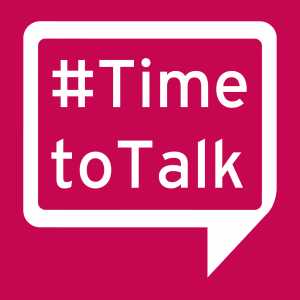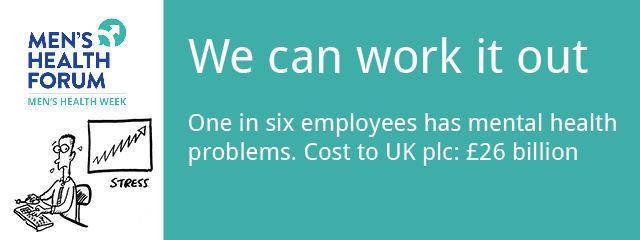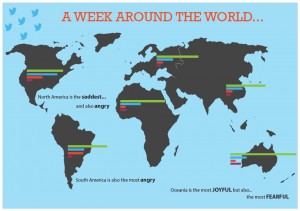
Mental Health around the world!
As regular readers of this blog know I am fascinated by the use of social media to promote health and wellness. So you can imagine how interested I was in the just released We Feel Twitter tool.
Black Dog Institute and Commonwealth Scientific and Industrial Research Organisation (CSIRO) have just released ‘We Feel’ an product which analyses the words from all those millions we send outs to show a real-time view of our emotions.
“So what” I hear you cry. Sounds a bit of a gimmick. Not so!
We Feel should be able to determine factors which cause emotions to fluctuate over time. These could be social, economic and environmental factors such as weather, time of day, news of a natural disaster or political instability.
From a health point of view We Fell should be able to increase understanding of community mental health and assist in the sensible allocation of relevant services.
Professor Helen Christensen who heads up Aussie based Black Dog Institute thinks that ” We Feel represents the world’s first foray into understanding how social media can be used to detect poor mental health and observe shifts according to time and place”
Christensen takes the view much of the data we use is well past its sell by date! She adds “Should the real-time data gained using this incredible tool prove accurate, we will have the unique opportunity to monitor the emotional state of people across different geographical areas and ultimately predict when and where potentially life-saving services are required.”
So how does it work?
“We Feel looks for up to 600 specific words in a stream of around 27 million tweets per day and maps them to a hierarchy of emotions which includes love, joy, surprise, anger, sadness and fear. You can explore emotion and trends on a minute by minute time scale, across locations around the globe and gender to further refine the result” says Dr Cecile Paris, Research leader in language and social computing at CSIRO’s Digital Productivity and Services Flagship told PatientTalk.Org.
If you want to have a look at We Feel then drop round to http://wefeel.csiro.au.
Black Dog Institute have produce a rather useful FAQ for We Feel which we share below.
What is We Feel?
We Feel is a tool developed by CSIRO for The Black Dog Institute that aims to verify whether social media can accurately map emotions of human populations. The online tool passively analyses a ‘massive pipe’ of Tweets up to 32,000 tweets per minute on average, or around 27 million tweets per day, CSIRO uses language-processing techniques to look at the English words people use in their Twitter posts. We Feel then maps these words to a hierarchy or ‘wheel of emotions’, offering a summary view of the prevalence of different emotions across the world.
What is the reason for the project?
The aim of this project is to validate the use of Twitter as a tool for measuring mental health of a “community” of people.
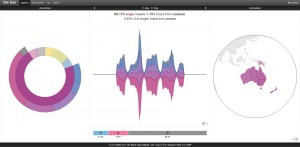
Tweeting in Anger
In addition to providing real time population data, this tool will also help us to uncover where people are most at risk of poor mental health and how the mood and emotions of an area/region can fluctuate over time. We Feel will also help us to understand how strongly our emotions are related to social, economic and environmental factors such as the weather, time of day, day of the week, news of a major disaster or a downturn in the economy. This information is of vital importance to the health services industry who can potentially use it to both monitor community mental health and predict where/when services need to be assigned.
Having access to real-time data is also of enormous benefit to mental health researchers. Currently, research and potentially life-saving public health programs are based on statistics that may be years old. Further to this, our current data sets are based on snapshots of a particular place and time. Twitter offers a large and fast sample of information that could hold the key to a real-time view of our emotions.
Finally, this project is supporting Black Dog Institute researchers to gather evidence on role of social media in the development of more effective public health campaigns as well as the evaluation of existing campaigns.
What are some of the limitations of Twitter for big data analytics?
The main limitation of using Twitter is that it provides only limited information about the people tweeting. We Feel currently makes assumptions on the gender (using people’s names) and location (using time zones) of tweeters. We would like to provide other demographic breakdowns (e.g. age, profession) in the future but this currently this information is not available.
They also share a fair bit of more technically orientated information which may be of use to researchers and potential users.
How does We Feel work?
In order to create ‘We Feel’, CSIRO researchers had to create an emotional map. To do this they set up a crowd-sourcing task on the internet and asked people to look at a sample of 600 words in our vocabulary that relate to emotions and asked them 1. Is the word an emotion? and 2. Which emotions does the word best correspond to?
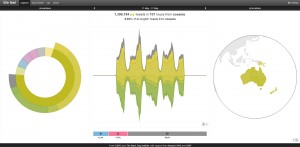
Tweet with Joy
The researchers then plotted these emotions across a four quadrant scale and selected colours that corresponded to the emotions (Yellow= Surprise, Green = Joy, Red= Anger, Blue= sadness for example) in order to design the user interface.
CSIRO researchers wrote several data mining applications to analyse the Tweets, which look for key words associated with emotions, use geographic location where available or determine it based on time zone and allocate gender based on an analysis of Twitter names.
What types of emotions are analysed by the tool?
The emotions are based on US Psychology Professor W. Gerrod Parrott’s standard list of basic emotions including love, joy, surprise, anger, sadness and fear. Each of these emotions is then segmented further to a list of more specific secondary emotions – for example, the primary emotion of sadness includes suffering, disappointment, shame, neglect and sympathy.
We Feel allows researchers to explore each of these emotions and its sub emotions on a segmented coloured wheel and look at its prevalence over time. Users can also explore emotions across different locations around the globe to further refine the results.
Can We Feel analyse Tweets in languages other than English?
We Feel currently only analyses Tweets in English but it is possible to translate the technology into other languages with further development and research.
What is the output of the We Feel initiative? Will there be a report issued from BDI/CSIRO based on the insights found from the tool?
There will be a report issued to the NSW mental health commission at the conclusion of the project. Researchers have only just started analysing the signal, and will need a backlog of a few months of data before they can verify patterns and trends.
Is this spying or invading people’s privacy?
We Feel uses publically available information from tweets people post on Twitter. It doesn’t identify individuals, analyse direct messages, monitor private accounts or protected tweets. On Twitter everything you post is public (by default) and is therefore is available to be analysed. We Feel offers a summary view of the prevalence of different emotions across the world.
Why doesn’t this tool analyse emotions from Facebook posts?
Whilst Facebook has a lot of information about who we are and how we feel, each Facebook account has strict privacy settings so the information in posts isn’t necessarily available and thus suitable for this kind of analysis.
How do you identify emotions?
We Feel uses a large vocabulary of emotion terms that were compiled from multiple sources, including the ANEW and LIWC corpora, and a list of moods from LiveJournal. We conducted a crowdsourcing task (using Crowdflower) to organize these terms against Parrott’s hierarchy of emotions. The emotions are color-coded using a dataset of affective norms provided by the Center for Reading Research at Ghent University.
How do you identify gender?
We determine gender by inspecting the user name of a twitter account, and comparing it against large lists of male and female names obtained from the BabyNameMap project.
How do you obtain the tweets?
We Feel has three sources of tweets: a random 1% sample from the public Twitter API (affectionately known as the gardenhose), a random 10% sample from GNIP (called the decahose), and a third source that specifically monitors the public Twitter API for a large vocabulary of emotion terms (we call this the emohose).
What volume of tweets do you handle?
The gardenhose delivers about 900 thousand English tweets a day, of which about 250 thousand contain emotion terms. The decahose predictably delivers ten times that amount. The emohose delivers about 27 million English tweets a day, all of which contain emotion terms. That averages out to 19 thousand tweets per minute, though this fluctuates quite widely.
How do you handle the tweets?
We Feel relies heavily on the Amazon AWS infrastructure to deal with this volume of tweets. We use several EC2 instances to capture tweets, annotate them (with emotions, gender and rough location) and build up the summaries that are needed by the visualization. Communication between these instances is achieved with Kinesis: a simple yet highly scalable pipeline through which we funnel our tweets and annotations. This allows anything consuming the data to be freely restarted and rescaled without missing a beat (or tweet). The tweets are backed up to S3 and then archived to Glacier for cold storage and summarized into DynamoDB tables to be queried by the web application. We also use Cloudwatch to monitor everything.
How was the web interface constructed?
The We Feel website was made using AngularJS (from Google) and Bootstrap (originally from Twitter). The visualizations were constructed using D3, which is an open-source JavaScript Library created by Mike Bostock.
These excellent frameworks have allowed us to construct a highly responsive web application that should be able to run on any modern browser, without any annoying dependencies like Flash or Java. It has been tested most extensively on Chrome.
Can I use the information you are collecting?
Yes! Along with the visual explorer, We Feel provides a table builder and a REST API that researchers and developers can access. We hope you try these out, and find new exciting ways to explore and mash-up the data.
This data is shared under the CSIRO Data license, meaning that you can use the data royalty-free for any non-commercial purpose. We only ask that you get in touch with us before attempting any large-scale data collection (there are rate limits in place), and that you clearly acknowledge us with a link back to the wefeel.csiro.au website.

